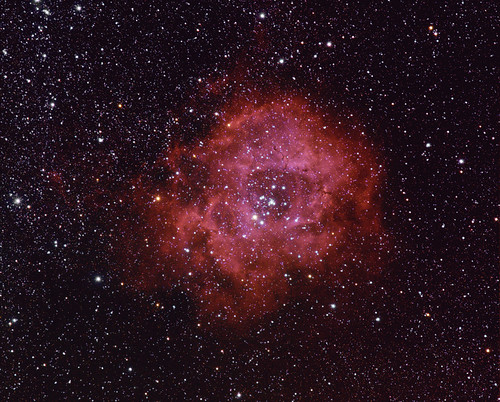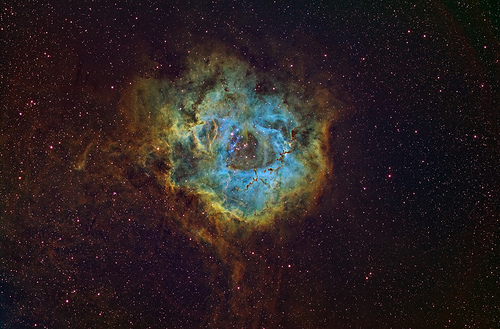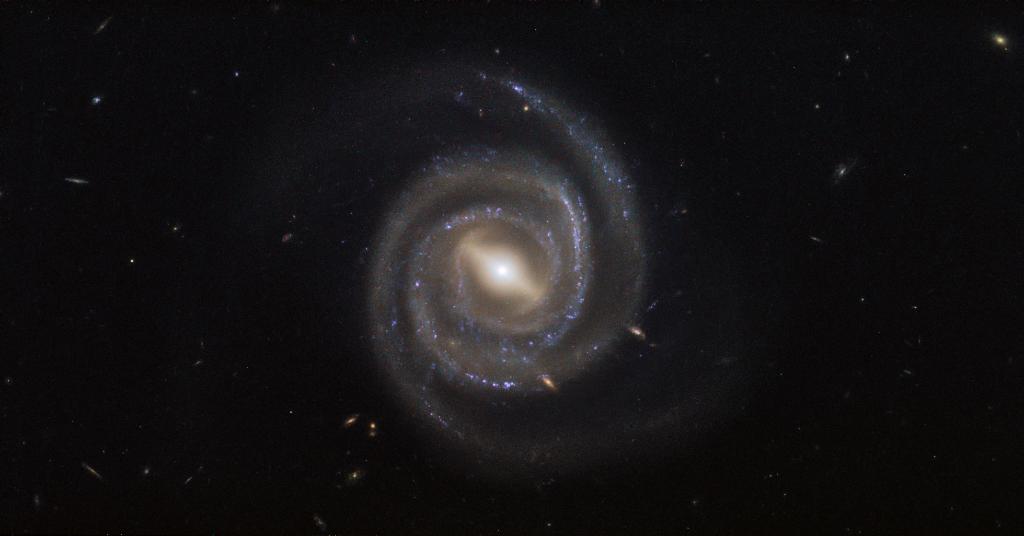Discussion
The Hubble space telescope was launched 28 years ago this week and now has a Flickr account:
https://www.flickr.com/photos/nasahubble/sets/7215...
Enjoy.
https://www.flickr.com/photos/nasahubble/sets/7215...
Enjoy.
Stunning.
I've been mulling pressing the 'Buy it Now' button on a Ritchey-Chrétien astrograph, although the nice folk at First Light Optics don't have a firm delivery date on one of the correct size...
https://www.firstlightoptics.com/offers/hubble-cas...
Do you think if the Hubble caught the Hourglass Nebula blinking, they would actually tell anyone?
All of the above really. Hubble's sensors can see visible light of course, but also into the infrared and ultraviolet. Colour images are combined from long exposure images taken through red, green & blue filters. Photos can be pieced together from a mosaic of images as well.
The James Webb space telescope (it it ever gets launched) will mostly work in the infra-red, rather than visible light. That's why it needs a hideously complex folding sun shield to protect it from the sun. It won't have any UV instruments though, which is a bit odd since that has proved useful on Hubble.
It'll also be orbiting so far out, that it won't be upgradeable or fixable like Hubble was. Not that the Shuttle is around to do that anymore anyway. Those were potentially tricky missions for the Shuttle. It was the only time they had two Shuttles on the pads at the same time, in case one had to go up to rescue the other.
 host image online
host image online
The James Webb space telescope (it it ever gets launched) will mostly work in the infra-red, rather than visible light. That's why it needs a hideously complex folding sun shield to protect it from the sun. It won't have any UV instruments though, which is a bit odd since that has proved useful on Hubble.
It'll also be orbiting so far out, that it won't be upgradeable or fixable like Hubble was. Not that the Shuttle is around to do that anymore anyway. Those were potentially tricky missions for the Shuttle. It was the only time they had two Shuttles on the pads at the same time, in case one had to go up to rescue the other.
 host image online
host image onlineBeati Dogu said:
...
The James Webb space telescope (it it ever gets launched) will mostly work in the infra-red, rather than visible light. That's why it needs a hideously complex folding sun shield to protect it from the sun. It won't have any UV instruments though, which is a bit odd since that has proved useful on Hubble.
...
It's low level visible light (orange and red) to mid Infrared, can see much lower frequencies than Hubble.The James Webb space telescope (it it ever gets launched) will mostly work in the infra-red, rather than visible light. That's why it needs a hideously complex folding sun shield to protect it from the sun. It won't have any UV instruments though, which is a bit odd since that has proved useful on Hubble.
...
Due to red-shift of far away Galaxies it's to allow it to see further back in time, than Hubble can.
Unfortunately no pretty false colour pictures of nebula's from JWST.
anonymous said:
[redacted]
Most are false colour using narrow band filtershttp://www.mcwetboy.com/mcwetlog/2010/04/falsecolo...
From the article above - this first image is pretty close to a 'true colour' image

Whilst this one of the same object uses narrow band imaging and a false colour palette (called the "hubble pallette"). Most images from HST use something like this. False colour is used to bring out much more detail in the image and make a more impact.

Edited by Moonhawk on Saturday 28th April 09:49
It is also interesting how Hubble's capabilities changed and improved over its life. There is a good video available on You Tube outlining how these upgrades enhanced its capabilities.
https://www.youtube.com/watch?v=JqZ2xtsJRGc
Hubble was designed from the outset (mid 1970s) to be launched from the cargo bay of the Shuttle and was also designed to be serviceable by regular visits from the Shuttle. Whilst this was overall a good thing (and pretty crucial in view of Hubble's early problems), it did mean that the telescope was actually placed in a less than ideal location from an astronomical point of view. JWT is being placed in a more astronomically friendly position but that does make it inaccessible for repairs and maintenance. Indeed, repair and maintenance has not been built into the design.
I think that was a bit short sighted because it looks like some of the next generation of manned spacecraft will have the ability to travel out to the location of the JWT.
https://www.youtube.com/watch?v=JqZ2xtsJRGc
Hubble was designed from the outset (mid 1970s) to be launched from the cargo bay of the Shuttle and was also designed to be serviceable by regular visits from the Shuttle. Whilst this was overall a good thing (and pretty crucial in view of Hubble's early problems), it did mean that the telescope was actually placed in a less than ideal location from an astronomical point of view. JWT is being placed in a more astronomically friendly position but that does make it inaccessible for repairs and maintenance. Indeed, repair and maintenance has not been built into the design.
I think that was a bit short sighted because it looks like some of the next generation of manned spacecraft will have the ability to travel out to the location of the JWT.
Wowzer! Really does seem like it was only yesterday that it was launched. If my memory serves me right, newsround and/or blue Peter made a half hour special. (40th is fast approaching reality, why does everything constantly show me that we are only here for a mere spec of time.. I'd redeem any wishes granted or euro millions win to be able to slow things down a bit!)
hypothetically, if I was a (very) rich man with money to burn, could I use my billions to point hubble at planet earth and take some nice pictures?
(off to Google the gasp at the amount of £££ has been spent to date etc)
hypothetically, if I was a (very) rich man with money to burn, could I use my billions to point hubble at planet earth and take some nice pictures?
(off to Google the gasp at the amount of £££ has been spent to date etc)
Pacman1978 said:
Wowzer! Really does seem like it was only yesterday that it was launched. If my memory serves me right, newsround and/or blue Peter made a half hour special. (40th is fast approaching reality, why does everything constantly show me that we are only here for a mere spec of time.. I'd redeem any wishes granted or euro millions win to be able to slow things down a bit!)
hypothetically, if I was a (very) rich man with money to burn, could I use my billions to point hubble at planet earth and take some nice pictures?
(off to Google the gasp at the amount of £££ has been spent to date etc)
It's not designed to look back at earth. You would probably damage the instruments on board if you tried.hypothetically, if I was a (very) rich man with money to burn, could I use my billions to point hubble at planet earth and take some nice pictures?
(off to Google the gasp at the amount of £££ has been spent to date etc)
Hubble does not magnify to any great extent. It's a light collector - optimised for looking at very faint objects.
Hubble is certainly related to the big highly-classified NRO spy satellites like the Keyhole & Misty series. Probably the same contractor - Lockheed Martin.
Anyway, for Star Wars day (May the 4th), here's a Hubble image of Galaxy UGC 6093, which is about 500 million light years away.

At the TIE Fighter-like centre is a supermassive black hole.
https://www.nasa.gov/image-feature/goddard/2018/hu...
Anyway, for Star Wars day (May the 4th), here's a Hubble image of Galaxy UGC 6093, which is about 500 million light years away.

At the TIE Fighter-like centre is a supermassive black hole.
https://www.nasa.gov/image-feature/goddard/2018/hu...
By the way, NASA was given two surplus (unlaunched) spy satellites by the the NRO (National Reconnaissance Office) in 2012. They're possible Block III Keyholes, but it's not known for sure.
They have the same 2.4 m mirror diameter as Hubble, but have adaptive optics and a wider field of view, which should make them a lot more capable.
NASA has been working on adapting one of them for their uses. The WFIRST (Wide Field Infrared Survey Telescope) satellite is expected to be launched in circa-2024 and will be used to search for other planets & so-called dark matter.
https://en.wikipedia.org/wiki/Wide_Field_Infrared_...
They have the same 2.4 m mirror diameter as Hubble, but have adaptive optics and a wider field of view, which should make them a lot more capable.
NASA has been working on adapting one of them for their uses. The WFIRST (Wide Field Infrared Survey Telescope) satellite is expected to be launched in circa-2024 and will be used to search for other planets & so-called dark matter.
https://en.wikipedia.org/wiki/Wide_Field_Infrared_...
Edited by Beati Dogu on Friday 4th May 21:18
Beati Dogu said:
Hubble is certainly related to the big highly-classified NRO spy satellites like the Keyhole & Misty series. Probably the same contractor - Lockheed Martin.
Anyway, for Star Wars day (May the 4th), here's a Hubble image of Galaxy UGC 6093, which is about 500 million light years away.

At the TIE Fighter-like centre is a supermassive black hole.
https://www.nasa.gov/image-feature/goddard/2018/hu...
The optics used in Hubble are based on a 1970s era spy satellite. However, it's the instrumentation that is optimised for seeing faint objects. If you pointed Hubble at the earth, you would damage the instruments. Hubble's great advantage over ground based telescopes is not because it magnifies things better. It's because it is placed above the atmosphere and can observe without atmospheric interference. Since Hubble went into operation, new picture enhancement techniques have allowed ground based telescopes to start approaching Hubble's levels of clarity.Anyway, for Star Wars day (May the 4th), here's a Hubble image of Galaxy UGC 6093, which is about 500 million light years away.

At the TIE Fighter-like centre is a supermassive black hole.
https://www.nasa.gov/image-feature/goddard/2018/hu...
Hubble's magnification powers are similar to what a spy satellite could do circa 1975.
Astronomical telescopes are designed to collect light rather than as simple magnifiers.
eharding said:
Stunning.
I've been mulling pressing the 'Buy it Now' button on a Ritchey-Chrétien astrograph, although the nice folk at First Light Optics don't have a firm delivery date on one of the correct size...
https://www.firstlightoptics.com/offers/hubble-cas...
Do you think if the Hubble caught the Hourglass Nebula blinking, they would actually tell anyone?
Probably useful for looking for Corbins election chances.I've been mulling pressing the 'Buy it Now' button on a Ritchey-Chrétien astrograph, although the nice folk at First Light Optics don't have a firm delivery date on one of the correct size...
https://www.firstlightoptics.com/offers/hubble-cas...
Do you think if the Hubble caught the Hourglass Nebula blinking, they would actually tell anyone?
Come back when you've produced some images. [not of abbotushippopotamus mind]
Eric Mc said:
Beati Dogu said:
Hubble is certainly related to the big highly-classified NRO spy satellites like the Keyhole & Misty series. Probably the same contractor - Lockheed Martin.
Anyway, for Star Wars day (May the 4th), here's a Hubble image of Galaxy UGC 6093, which is about 500 million light years away.

At the TIE Fighter-like centre is a supermassive black hole.
https://www.nasa.gov/image-feature/goddard/2018/hu...
The optics used in Hubble are based on a 1970s era spy satellite. However, it's the instrumentation that is optimised for seeing faint objects. If you pointed Hubble at the earth, you would damage the instruments. Hubble's great advantage over ground based telescopes is not because it magnifies things better. It's because it is placed above the atmosphere and can observe without atmospheric interference. Since Hubble went into operation, new picture enhancement techniques have allowed ground based telescopes to start approaching Hubble's levels of clarity.Anyway, for Star Wars day (May the 4th), here's a Hubble image of Galaxy UGC 6093, which is about 500 million light years away.

At the TIE Fighter-like centre is a supermassive black hole.
https://www.nasa.gov/image-feature/goddard/2018/hu...
Hubble's magnification powers are similar to what a spy satellite could do circa 1975.
Astronomical telescopes are designed to collect light rather than as simple magnifiers.
Eric Mc said:
Hubble's magnification powers are similar to what a spy satellite could do circa 1975.
Astronomical telescopes are designed to collect light rather than as simple magnifiers.
Yep - and any telescope's magnification power is limited by physics.Astronomical telescopes are designed to collect light rather than as simple magnifiers.
The maximum resolution of any telescope is limited by the diameter of it's main optical element (the main mirror in the case of Hubble). The maximum theoretical angular resolution of a telescope with a circular aperture is given by the formula:
θ = 1.220 * λ / D
That's why Hubble cannot see the Apollo hardware on the moon - it's main mirror simply isn't big enough (a fact conspiracy theorists conveniently ignore).
Hubble can only resolve objects that are around 100 metres across or larger on the moon's surface. To resolve something like the american flag (~1.2m across) on the surface off the moon would require a telescope with a main mirror around 200m in diameter.
As a point of comparison - the largest optical telescope currently under construction and due for completion in 2025, is the Giant Magellan Telescope - which has a 25 metre main mirror assembly.
Hubble's specialty is being able to collect the very low light emitted by very faint (i.e. very far away) objects. It is helped in this ability by being above the turbulence caused by the earth's atmosphere and being very stable.
It is NOT designed to look at nearby bright objects - such as the earth, moon or sun. To do so would cause irreparable damage to the sensitive instruments it carries.
It is NOT designed to look at nearby bright objects - such as the earth, moon or sun. To do so would cause irreparable damage to the sensitive instruments it carries.
I know that if I want to see what artefacts my sensor produces, I blank off the eyepiece, cap the lens then put it all in a cloth back to remove the light then take a picture. That will show up artefacts, I can then use that to remove that info from any deep field inmgaes I try to take. I assume Hubble can do something similar.
jmorgan said:
I know that if I want to see what artefacts my sensor produces, I blank off the eyepiece, cap the lens then put it all in a cloth back to remove the light then take a picture. That will show up artefacts, I can then use that to remove that info from any deep field inmgaes I try to take. I assume Hubble can do something similar.
And I am sure they take multiple images of various target objects so if something "new" turns up in an image, they have ways and means to see if that new item is a genuine astronomical phenomenon (such as a supernova in a distant galaxy) or something generated internally in Hubble or the processing equipment.Gassing Station | Science! | Top of Page | What's New | My Stuff



